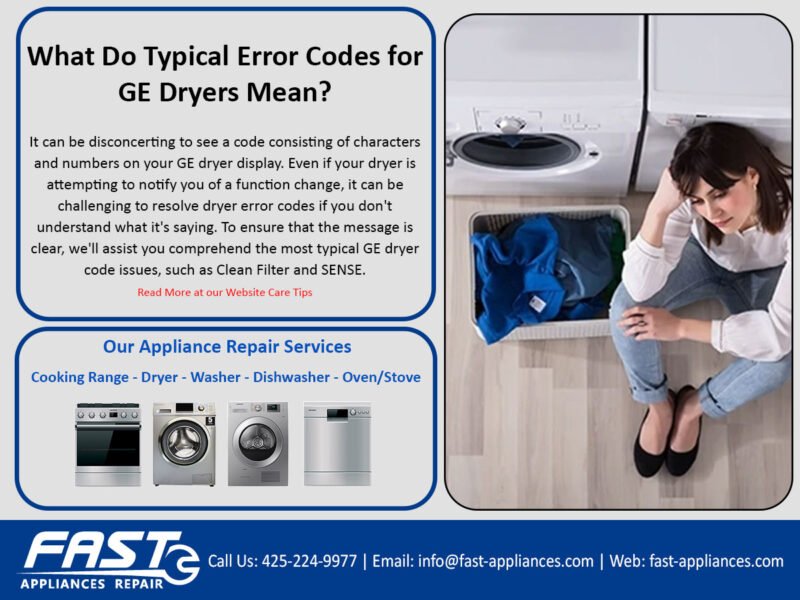
The F1 error code in GE dryers is an indicator that something isn’t right. Essentially, it’s the dryer’s way of telling you that it needs a little attention. Much like when your car’s check engine light flicks on, it could be a minor issue or something that requires further investigation. The key is understanding what causes this error and knowing how to address it so you can get back to drying your clothes without a hitch.
Understanding the F1 Error Code
The F1 error code is a common issue that many GE dryer owners encounter. It typically signals a problem with the dryer’s main control board or a sensor issue. Think of the control board as the brain of your dryer; if the brain isn’t functioning correctly, the rest of the machine can’t either. This can be due to a faulty connection, a glitch, or even a component failure.
You might be wondering why this happens. Well, dryers are subject to a lot of heat and vibrations. Over time, these can cause connections to loosen or sensors to fail. It’s like how a computer can start acting up if its parts get jostled or overheated. Another possibility is a power surge that may have disrupted the control board’s normal operations.
If you’ve seen this error, don’t panic. While it might seem daunting, it’s often a fixable problem. Knowing what to look for is half the battle. In the next sections, we’ll dive into the most common causes of this error and how to address them.
Control Board Malfunctions
The control board, as we’ve mentioned, plays a crucial role in the operation of your dryer. It’s like the conductor of an orchestra, ensuring each part plays its role at the right time. When the control board malfunctions, the F1 error code is often triggered. This could be due to a simple glitch or a more significant issue like a hardware failure.
One cause could be a power surge, much like a sudden jolt of electricity. Just as a lightning strike can knock out power, a surge can mess with the delicate electronics of your dryer. Over time, components within the board may also wear out due to normal use—much like how a well-loved book might start losing pages.
To address this, you might need to reset the dryer or, in some cases, replace the control board. It’s like rebooting your computer when it crashes; sometimes, that’s all it takes to resolve minor issues. However, if the problem persists, consulting a professional might be your next step.
Sensor and Wiring Issues
Sometimes, the F1 error might be due to sensor or wiring problems. Sensors in your dryer act like the senses we rely on to navigate the world. If a sensor isn’t working correctly, the dryer might not be able to “see” or “feel” what it’s supposed to, resulting in that pesky error code.
Wiring issues can also be the culprit. Think of wires as the veins and arteries in our bodies, carrying signals and power throughout the appliance. A loose connection or damaged wire is like a blocked artery, preventing the dryer from functioning properly. Over time, wires can become worn or disconnected due to vibrations and heat exposure.
To troubleshoot, you might need to inspect these components. Ensure all connections are secure, and there are no visible signs of damage. If you’re unsure, reaching out to a technician can be a wise move. They have the tools and expertise to diagnose and fix these issues effectively.
Preventive Measures and Final Thoughts
Now that we’ve explored the common causes of the F1 error, let’s discuss what you can do to prevent it from happening again. Regular maintenance is key, much like how routine check-ups help keep us healthy. Keeping your dryer clean and ensuring it’s in a well-ventilated area can reduce the risk of overheating and dust buildup, which are common culprits of electronic failure.
Try to avoid overloading your dryer. It might seem convenient to cram in as much as possible, but just like an overloaded backpack can strain your shoulders, an overloaded dryer can strain its components. By being mindful of the load size, you can extend the life of your machine.
In conclusion, while an F1 error code can be frustrating, it doesn’t have to be a disaster. With a bit of patience and investigation, you can often troubleshoot the issue yourself. If not, professionals are always there to help. By understanding and addressing the root causes, you can enjoy a smoothly running dryer and avoid unexpected breakdowns in the future.